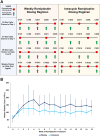Thrombopoietin receptor agonists for chemotherapy-induced thrombocytopenia: a new solution for an old problem
- PMID: 36485134
- PMCID: PMC9821429
- DOI: 10.1182/hematology.2022000374
Thrombopoietin receptor agonists for chemotherapy-induced thrombocytopenia: a new solution for an old problem
Abstract
Chemotherapy-induced thrombocytopenia (CIT) is common, resulting in increased bleeding risk and chemotherapy delays, dose reduction, and treatment discontinuation, which can negatively affect oncologic outcomes. The only agent approved by the US Food and Drug Administration to manage CIT (oprelvekin) was voluntarily withdrawn from the market by the manufacturer, leaving few options for patients. Therefore, patients experiencing CIT present a significant clinical challenge in daily practice. The availability of thrombopoietin receptor agonists has led to formal clinical trials describing efficacy in CIT as well as a rather extensive body of published observational data from off-label use in this setting but no formal regulatory indications for CIT to date. The accumulated data, however, have affected National Comprehensive Cancer Network guidelines, which now recommend consideration of TPO-RA clinical trials as well as off-label use of romiplostim. This review article details the evidence to date for the management of CIT with thrombopoietin receptor agonists (TPO-RAs), discussing the efficacy data, the specific circumstances when treatment is warranted (and when it is generally unnecessary), and safety considerations. Specific recommendations regarding patient selection, initiation, dosing, titration, and discontinuation for TPO-RA therapy in CIT are given, based on published data and expert opinion where evidence is lacking.
Copyright © 2022 by The American Society of Hematology.
Conflict of interest statement
Hanny Al-Samkari: Consultancy (Agios, Dova/Sobi, Novartis, Rigel, argenx, Forma), Research Funding (Agios, Dova/Sobi, Amgen).
Figures




References
-
- Kuter DJ. Managing thrombocytopenia associated with cancer chemotherapy. Oncology (Williston Park). 2015;29(4):282-294. - PubMed
Publication types
MeSH terms
Substances
Grants and funding
LinkOut - more resources
Full Text Sources

